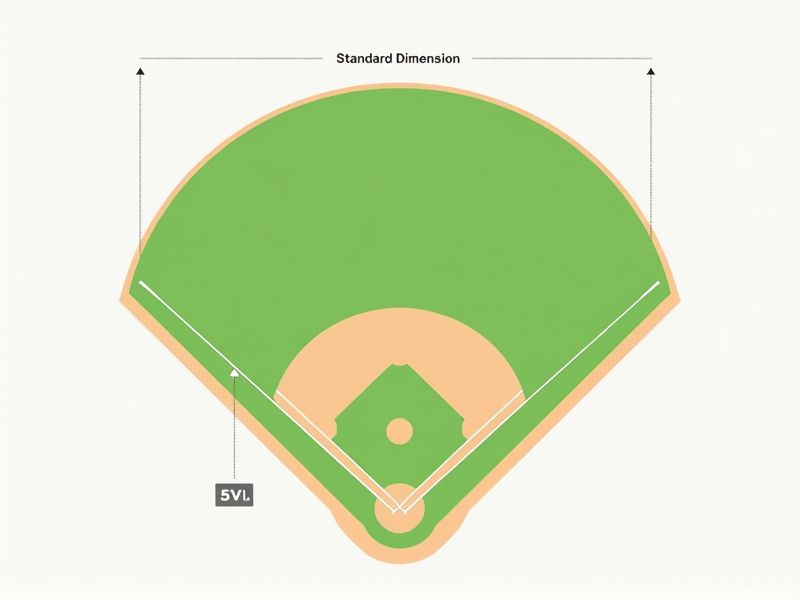
When considering the standard dimensions of a baseball field, it's important to know that these measurements can vary depending on the level of play. For Major League Baseball, the distance from home plate to the outfield fences is typically about 320 feet down the foul lines and between 400 and 420 feet to center field. The bases are always 90 feet apart, and the pitcher's mound is set at 60 feet, 6 inches from home plate. Knowing these dimensions can help you better understand the scale of the field, whether you're planning field setup or analyzing gameplay strategies.
Base Path Length
The standard base path length in a baseball field measures 90 feet, essential for ensuring consistent gameplay and player movement. Each base--first, second, and third--maintains this distance, creating a diamond shape that facilitates strategic plays. Home plate to the pitcher's mound measures 60 feet 6 inches, further emphasizing the precise dimensions vital for pitcher-batter interactions. Understanding these measurements can enhance your appreciation of the game's dynamics and player performance.
Pitcher'S Mound To Home Plate Distance
The standard distance from the pitcher's mound to home plate in Major League Baseball is precisely 60 feet, 6 inches. This measurement is crucial as it directly affects pitching dynamics and batter performance. In youth leagues, this distance may vary, often being reduced to 46 feet for younger players. Ensuring accurate dimensions is essential for maintaining the integrity of the game at all levels.
Outfield Fence Distance
The standard outfield fence distance in Major League Baseball (MLB) varies significantly from park to park, typically ranging from 325 to 400 feet from home plate. Many stadiums feature a combination of symmetrical and asymmetrical fence designs, influencing how hitters and pitchers strategize. For example, Fenway Park's left field is only 310 feet, while that of Coors Field extends to 450 feet in center field. Understanding these dimensions can enhance your appreciation of game dynamics and player performance on different fields.
Home Plate To Backstop Distance
The distance from home plate to the backstop in a standard baseball field is typically between 60 to 70 feet, ensuring enough space for players and officials. This measurement allows for optimal ball recovery and safety, especially for catchers and umpires during the game. The backstop is often constructed from durable materials like chain-link fencing to withstand the impact of foul balls and wild pitches. By maintaining this standard distance, your field will enhance gameplay while providing the necessary protection for spectators and players alike.
Infield Diamond Size
The standard size of a baseball infield diamond is defined by the distance between the bases, specifically measuring 90 feet from each base to the next. This creates a square, resulting in a total infield area of approximately 2.6 acres when including the pitcher's mound, located 60 feet 6 inches from home plate. The infield dirt is typically 8 to 10 inches deep, designed to promote optimal drainage and fluid gameplay. Maintaining these dimensions is crucial, as they influence player performance and the overall integrity of the sport.
Pitcher'S Mound Height
The standard height of a pitcher's mound in Major League Baseball is 10 inches above home plate, following the regulations set by the official baseball rules. This specific height affects pitching mechanics, ball trajectory, and overall game dynamics, impacting player performance at competitive levels. The distance from the pitcher's mound to home plate is precisely 60 feet 6 inches, making it crucial for pitchers to master their technique within this specified range. Understanding these measurements can enhance your appreciation for the intricacies of the game and how they influence strategy and outcomes.
Foul Line Length
The foul line length in a standard baseball field measures 325 feet to the foul poles in the outfield from home plate. This distance ensures a balanced gameplay, promoting equal opportunities for batters and fielders. The angle and placement of the foul lines help enforce the rules regarding fair and foul territory, significantly influencing game strategy. When designing your own diamond or assessing a local field, keeping this standard in mind is crucial for maintaining the integrity of the sport.
Batter'S Box Dimensions
The dimensions of the batter's box in Major League Baseball are precisely defined, measuring 4 feet wide and 6 feet long. Positioned 60 feet 6 inches away from the pitcher's mound, the batter's box serves as the designated area where you stand while at bat. Each box has a chalk line marking, helping to maintain consistency across all fields. Understanding these measurements is crucial for players and coaches to ensure proper stance and technique during gameplay.
Distance Between Bases
The distance between bases on a standard baseball field is 90 feet, which is vital for gameplay dynamics and player movement. This measurement ensures that players can utilize their speed and agility effectively during base running and defensive plays. Understanding this spacing is essential for optimizing your training routines, as it directly impacts your base running techniques and defensive strategies. Furthermore, the total infield distance from home plate to the pitcher's mound is 60 feet 6 inches, underscoring the precise geometry of the game.
Grass Line Arc Distance
The standard baseball field features a precisely defined grass line arc distance, measuring 120 feet from home plate to the outfield. This arc creates a seamless transition between the infield's dirt and the outfield's grass. The optimal grass line not only enhances the aesthetic appeal but also plays a crucial role in gameplay, influencing how the ball interacts with the field surface. For players, understanding this distance can significantly affect their fielding and baserunning strategies during a game.
